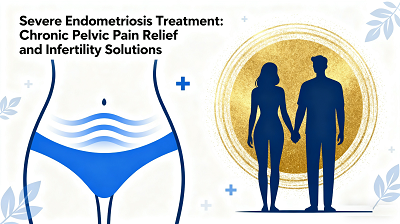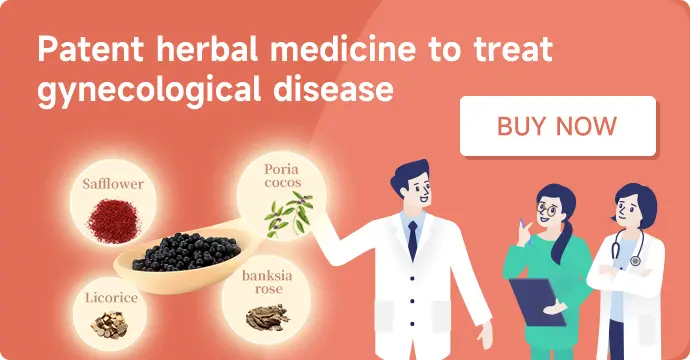Severe Endometriosis Treatment: Chronic Pelvic Pain Relief and Infertility Solutions
Endometriosis affects approximately 1 in 10 women of reproductive age worldwide, and for those with the severe form, the impact goes far beyond monthly discomfort. Chronic pelvic pain that lingers for weeks (or even months) and the heartbreak of infertility are common, life-altering challenges. Unlike mild endometriosis, severe cases involve extensive growth of endometrial-like tissue outside the uterus—on the ovaries, fallopian tubes, pelvic lining, or even other organs like the bladder or intestines. This abnormal tissue growth triggers inflammation, scarring, and adhesions (tissue bands that bind organs together), leading to relentless pain and blocked fertility pathways.

If you’re struggling with severe endometriosis, you’re not alone—and effective solutions exist. This guide breaks down the link between severe endometriosis, chronic pelvic pain, and infertility, plus evidence-based treatments (including Traditional Chinese Medicine like Fuyan Pill and lifestyle adjustments to help you regain control.
Understanding the Link: Severe Endometriosis → Chronic Pelvic Pain → Infertility
To address these issues, it’s first critical to understand how they’re connected. Endometriosis occurs when tissue similar to the uterine lining (endometrium) grows outside the uterus. In severe cases:
1. Why Chronic Pelvic Pain Develops
Inflammation: Abnormal endometrial tissue responds to hormonal changes during the menstrual cycle, swelling and bleeding just like the uterine lining. But since this tissue has no way to exit the body, trapped blood and fluid trigger intense inflammation. This inflammation irritates surrounding nerves, causing dull, aching pain that may worsen during menstruation, sex (dyspareunia), or even daily activities like walking or sitting.
Scarring and Adhesions: Over time, repeated bleeding and inflammation lead to scar tissue and adhesions. These tough bands of tissue can stick pelvic organs (e.g., ovaries, fallopian tubes) to each other or the pelvic wall, pulling and stretching nerves—resulting in constant, sharp pain that doesn’t ease with over-the-counter painkillers.
2. Why Infertility Occurs
Severe endometriosis is one of the leading causes of female infertility, affecting 30–50% of patients. The main reasons include:
Blocked Fallopian Tubes: Adhesions or endometriomas (cysts filled with old blood, common in severe cases) can twist or block fallopian tubes, preventing sperm from reaching the egg or a fertilized egg from traveling to the uterus.
Ovarian Dysfunction: Endometriomas or inflammation can damage ovarian tissue, reducing egg quality or preventing normal ovulation.
Impaired Implantation: Chronic inflammation changes the pelvic environment, making it harder for a fertilized egg to implant in the uterus.
Evidence-Based Treatments for Severe Endometriosis: Pain Relief & Fertility Support
Treating severe endometriosis requires a personalized approach, often combining medical interventions, surgical options, and holistic therapies. Below are the most effective solutions for both pain management and improving fertility.
1. Western Medical Treatments: Controlling Pain and Inflammation
Hormonal Therapies: Birth control pills, progestins, or gonadotropin-releasing hormone (GnRH) agonists can suppress estrogen (the hormone that fuels endometrial tissue growth). These medications reduce pain and slow tissue spread but do not cure endometriosis. Note: GnRH agonists are typically used short-term (6 months or less) due to side effects like hot flashes or bone density loss.
Pain Management: Nonsteroidal anti-inflammatory drugs (NSAIDs) like ibuprofen may ease mild pain, but severe cases often require prescription pain relievers (e.g., opioids) for short periods. For long-term pain, nerve blocks or transcutaneous electrical nerve stimulation (TENS) devices can help by interrupting pain signals.
Surgical Intervention: Laparoscopic surgery (minimally invasive) is the gold standard for severe endometriosis. Surgeons remove or ablate (destroy) abnormal tissue, cut adhesions, and drain endometriomas. In extreme cases (e.g., extensive organ damage), a hysterectomy (removal of the uterus) may be recommended, though this is a last resort for women who no longer wish to conceive.
2. Traditional Chinese Medicine (TCM): A Holistic Approach with Fuyan Pill
For women seeking natural, long-term relief—especially those hoping to preserve fertility—TCM offers a powerful complement to Western treatments. TCM views severe endometriosis as a result of “blood stasis,” “damp-heat,” or “kidney deficiency” (imbalances in the body’s energy, or qi). The goal is to clear these imbalances, reduce inflammation, and restore the pelvic environment for fertility.
Key TCM Treatment: Fuyan Pill
Fuyan Pill is a classic TCM herbal formula specifically designed for gynecological conditions like severe endometriosis. It combines over 50 herbs (e.g., Houttuyniae Herba, Scutellariae Radix, Persicae Semen) to target the root causes of endometriosis:
Clears Damp-Heat and Inflammation: Herbs like Houttuyniae Herba (Yuxingcao) and Scutellariae Radix (Huangqin) reduce pelvic inflammation, easing the burning or stabbing pain associated with severe endometriosis.
Resolves Blood Stasis: Ingredients like Persicae Semen (Taoren) and Carthami Flos (Honghua) improve blood circulation in the pelvis, breaking down scar tissue and adhesions that cause chronic pain and block fertility pathways.
Regulates Hormones and Improves Fertility: By balancing qi and blood, Fuyan Wan helps regulate the menstrual cycle and create a healthier pelvic environment for egg implantation. Many women with severe endometriosis report reduced pain and improved fertility after 3–6 months of consistent use.
Acupuncture for Pain and Fertility
Acupuncture complements Fuyan Wan by unblocking meridians (energy pathways) in the pelvis, reducing pain, and improving blood flow to the ovaries and uterus. Common acupoints used include:
Sanyinjiao (SP6): Located on the inner leg, 3 finger-widths above the ankle—balances the liver, spleen, and kidneys, easing pelvic pain.
Guanyuan (CV4): Below the navel—regulates the reproductive system and improves fertility.
Qihai (CV6): Also below the navel—reduces inflammation and calms pain.
Most patients notice reduced pain after 4–6 acupuncture sessions, and regular treatment (1–2 times weekly for 3 months) can improve ovulation and implantation rates.
3. Assisted Reproductive Technology (ART) for Infertility
For women with severe endometriosis who struggle to conceive naturally, ART options like in vitro fertilization (IVF) are often effective. IVF bypasses blocked fallopian tubes by fertilizing eggs with sperm in a lab, then transferring the embryo to the uterus. To improve success rates:
Pretreatment: Many doctors recommend 2–3 months of hormonal therapy or TCM (e.g., Fuyan Pill) before IVF to reduce inflammation and improve egg quality.
Surgical Prep: Laparoscopic surgery to remove endometriomas or adhesions before IVF can increase embryo implantation rates by up to 30%.
Lifestyle Adjustments to Manage Pain and Support Fertility
No treatment plan is complete without lifestyle changes—they reduce inflammation, ease pain, and create a fertility-friendly body. Here’s what to focus on:
1. Anti-Inflammatory Diet
Eat More: Fatty fish (salmon, mackerel) rich in omega-3s (reduce inflammation), leafy greens (spinach, kale) high in iron (combat anemia from heavy periods), and antioxidant-rich foods (blueberries, dark chocolate) to protect egg quality.
Avoid: Processed foods, sugar, and refined carbs (fuel inflammation), caffeine and alcohol (disrupt hormones and reduce fertility), and dairy (some women find it worsens pelvic pain—try plant-based milks like almond or oat).
2. Stress Management
Chronic stress raises cortisol levels, which worsen inflammation and disrupt hormone balance—making endometriosis pain and infertility worse. Try:
Mind-Body Practices: Yoga (focus on gentle poses like child’s pose or cat-cow to stretch the pelvis), meditation, or deep breathing exercises (10 minutes daily using apps like Headspace).
Relaxation Techniques: Warm baths with Epsom salts (magnesium eases muscle tension), aromatherapy (lavender or chamomile oil to calm stress), or gentle massage of the lower back and abdomen.
3. Movement and Exercise
While intense exercise may worsen pain during flares, gentle movement improves blood flow and reduces inflammation. Try:
Walking: 20–30 minutes daily—low-impact and easy to fit into a busy schedule.
Swimming: Water supports the body, reducing pressure on the pelvis while improving circulation.
Pelvic Floor Exercises: Kegels or pelvic tilts strengthen pelvic muscles, easing pain and improving bladder control (a common issue with severe endometriosis).
4. Sleep Hygiene
Poor sleep worsens pain and reduces fertility. Aim for 7–9 hours nightly by:
Creating a consistent sleep schedule (go to bed and wake up at the same time daily).
Avoiding screens 1 hour before bed (blue light disrupts melatonin).
Using a heating pad on the lower belly before bed to ease pain and promote relaxation.
Common Myths About Severe Endometriosis Debunked
Myth 1: “Severe endometriosis means you can never have kids.”
Fact: While infertility is common, it’s not inevitable. With IVF, surgical intervention, or TCM (like Fuyan Wan), 60–70% of women with severe endometriosis can conceive.
Myth 2: “Hysterectomy is the only cure.”
Fact: Hysterectomy removes the uterus but not all endometrial tissue—pain can still recur. It’s only recommended for women with no desire to conceive and severe, unmanageable pain.
Myth 3: “Natural treatments don’t work for severe cases.”
Fact: TCM (e.g., Fuyan Pill) and lifestyle changes can significantly reduce pain and improve fertility, even in severe endometriosis. They work best when combined with Western treatments like surgery or IVF.
Conclusion
Severe endometriosis with chronic pelvic pain and infertility is challenging, but it does not have to define your life. By combining Western medical treatments (hormones, surgery, IVF) with TCM (Fuyan Pill, acupuncture) and lifestyle adjustments, you can manage pain, improve your fertility odds, and regain control of your health.
The key is to work with a team of specialists—including a gynecologist who specializes in endometriosis, a TCM practitioner, and a fertility specialist—to create a personalized plan. Remember: every woman’s body is different, and what works for one person may not work for another. Be patient, stay consistent with your treatment, and don’t hesitate to advocate for yourself.
You deserve to live free from chronic pain and to achieve your dream of starting a family. With the right tools and support, it’s possible.
New Endometriosis Pill Approved on NHS: What This Means for Patients and the Role of Traditional Chinese Medicine
previous pageStruggling with Endometriosis Symptoms? Proven Back Pain and Painful Sex Relief Options
next page- Endometriosis and Debilitating Bowel & Bladder Pain: Diagnosis, Treatments, and Hope for Relief
- Struggling with Endometriosis Symptoms? Proven Back Pain and Painful Sex Relief Options
- Severe Endometriosis Treatment: Chronic Pelvic Pain Relief and Infertility Solutions
- New Endometriosis Pill Approved on NHS: What This Means for Patients and the Role of Traditional Chinese Medicine
- Can Endometriosis Be Endured Until Menopause?
Testimonials
- Adenomyosis with Ureaplasma Urealyticum Cured by Fuyan Pill
- Tubal blockage with hydrosalpinx can be cured by TCM shortly
- Fuyan Pill Helps A woman with Adenomyosis Get Pregnant
- A Woman with Hydrosalpinx Is Cured with Fuyan pill
- Pelvic Inflammatory Disease Testimonials
- Irregular Vaginal Bleeding and Endometrial Thickening Cured by Fuyan Pill
- Pruritus Vulvae and Frequent Urination: Mycoplasma Infection Cured after 2 Courses



